Be sure to click on the underlined words to see antique photos.
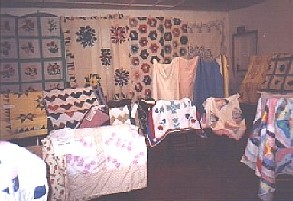
If you were shown three 19th century quilts made in the eastern U.S., another
Wales, the last Nova Scotia, you'd find it difficult to determine which came
from where.Nova Scotia, Canada, is at the furthest edge of North America. It lies
between Britain and the United States, as a peninsula jutting out from New
Brunswick. Surrounded by water, ships from far and near made their way bringing
people, fabrics, and other goods to the settlers there.
According to the book, the earliest inhabitants were the
Mi'kmaq. The French
established the first permanent European settlement in 1605, but Norse explorers
and Basque fishermen had been there long before from across the Atlantic. At
that time the region was loosely comprised of New Brunswick and Nova Scotia and
called Acadia.
In 1713 the British fought the French for Acadia and won. In 1749 they built
a large seaport in Halifax for their main defense against the French, who had
taken back their fortress in Louisbourg on Cape Breton Island under the Treaty
of Aix-la-Chapelle. But the British got it back and secured all of Nova Scotia
by 1758. It remained in their hands from then on. They proceeded to encourage
and arrange for Swiss and German immigrants to settle in Halifax, the capitol, and subsequently in
Lunenburg, further south on the Atlantic coast. The Scots came later, in 1773,
to settle in Cape Breton and Pictou County.
1907
stereoscopic view card of an apple orchard in NS
British intentions had been to establish themselves all along the coast
starting in Virginia. In 1755, Acadians were expelled from their homes and
deported to colonies in America and the West Indies. When they could finally
return in the 1760s, many found their homes destroyed and their farms taken over
by so-called "New England Planters."
The
Commons in Halifax
After the American Revolution, American families still faithful to the
British government moved and settled in Nova Scotia, including a substantial
number of Black settlers. Immigration from the British Isles and America
continued into the 1800s. With this settlement pattern, it is easy to understand
why particular quilt styles, techniques and
fabrics are found in Nova Scotia's
quilt heritage.
The oldest surviving quilt at the Nova Scotia Museum collection dates to
1810, yet a much earlier mention of a quilt appears in a 1754 newspaper. An ad
in the Halifax Gazette tells of a quilt for sale by an auctioneer. Household
inventories in the late 18th century indicate quilted petticoats were in fashion
there, and due to the large number, were likely imported from Britain. The
newspaper ads also tell us calico patches and strips were sold for "quiltings."
Some "patches" were from India and sold at two dollars each, a hefty
sum in those days. They also imported chintz, most likely from India.
Quilting offered social opportunities to both the rich and the poor, although
they were likely working with differing quality of
materials. Young girls
learned how to sew in school, and diaries are full of references to helping a
friend work on her quilt or going to a quilting. The term "Bee" is not
used by the diarists when recording a quilt get-together. Then, as well as
today, Nova Scotians prefer the term quilting or quilting party.
If differences must be recognized, these generalizations may apply: Nova
Scotians preferred making geometric pieced quilts more often then appliquéd ones. Borders are scarcely seen in their 19th century quilts; designs went to
the edge ending with a narrow binding. Canadian quilters in general used a lot
of white or unbleached cotton. Perhaps it was more readily available and
affordable. On a more cerebral level, I wonder if women found light colored
quilts more compelling to make as they endured less daylight during the long
winter season.
Cut-out chintz quilts were not found in NS. Instead, their
appliquéd quilts
were likely to be the red and green type. The nine block format was preferred
over the large four square or random appliqués style. Usually they were made
with a vine border.
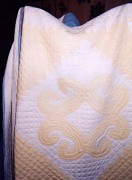 The Colonial Revival style of floral quilts in pastels, or
red on white are extant. It appears their green dyes were often fugitive as
indicated by blue or tan fabrics remaining where the green once was. The Colonial Revival style of floral quilts in pastels, or
red on white are extant. It appears their green dyes were often fugitive as
indicated by blue or tan fabrics remaining where the green once was.
<--- 1920s quilt - a wedding gift for Diana, made
by a church group
Mosaic quilts made there used the paper-pieced method of combining hexagons,
following in the traditions of the British Isles. Nova Scotians favored silks
for this pattern. The American type of Grandmother's Flower Garden quilts are
not in their collection.
The book states that Nova Scotians preferred the
English tradition for arranging their mosaic quilts, which may at times resemble
GFG, but are distinguishable putting the colorful prints into different
arrangements than a flower.
The earliest quilts follow the style of the frame quilts and wholecloths made
in Britain. The later quilts use multi-pieced blocks reflective of the American
tradition.
Given their cold and windy weather and self sufficient
living, small-scale
sheep raising was common. This means of course that wool quilts and wool batt
are evident. Yet, there is an absence of glazed wool or calamanco quilts in Nova
Scotia's history. Perhaps the sheep they raised were not long haired producers
of the fine worsted wool needed in order to call a quilt a calamanco. Wool batt
was carded by hand or larger sheets of batt were carded in their mills. Cotton
batting was imported. Wool quilts were tied or quilted with big stitches so they
could easily be taken apart for cleaning. They served both as beds and as
covers.
Wholesale
Dry Goods Warehouse
Solid colored wholecloth quilts were made of cotton, chintz or silk. White
wholecloth, in cotton or silk, were most likely to be heavily quilted. Two types
emerge. There are those adorned with traditionally American quilt patterns of
pineapples, and feather garlands and wreaths, or they made in traditionally
Welsh and northern England designs of circles, flower petals and Celtic circular
designs. The two different design styles did not overlap except for
crosshatching placed in the background of both. Otherwise, wholecloth quilts had
an overall quilted medallion pattern of borders around a large motif quilted in
the center. If the top was made in strips of solid fabrics, Strippey style, the
quilting flowed across the top, unconfined by the strips. This is more
indicative of Welsh quilting patterns than American.
Their crazy quilts look like American Victorian crazy's. There are several in
this book, all in high style, dating to the 1880s. Log cabin, pineapple, and
courthouse step are other foundation based quilts they made in silks, velvets
and cottons. The museum has an early version of the popular silk and velvet
tumbling block quilt, made about 1850 in Halifax or Bridgewater. It is fringed
and backed with a stunning seashell chintz in a yellow, salmon pink and green
print dating to the 1830s.
1871
Clothing Warehouse Store in Halifax
Treadle Sewing Machines
20th century quilters used scraps from old clothes, feed and flour sacks and
tobacco premiums for their quilts. Flour sacking was also used to make household
linens and clothing.
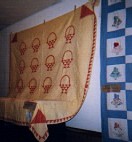 A
1930's girl, Helen Dacey Wilson, recalls her problems with wearing feedsack
clothing: A
1930's girl, Helen Dacey Wilson, recalls her problems with wearing feedsack
clothing:
<--- Quilt made of hand-dyed yellow feedsack w/red calico
print for a wedding gift.
"I remember one day my sister Elsie just refused to go to school because
the nurse was coming and Elsie's flour-bag slip and sugar-bag bloomers were new
and had not yet faded completely...On the back of her petticoat the words CREAM
OF THE WEST could be clearly seen- and a large still bright blue arrow pointing
to the words UNTIE HERE stood out plainly on the seat of her bloomers. Grete
told me that she remembers being invited to a cousin's house... and the group
decided to go swimming. Grete loved swimming and wanted to go too, but she
couldn't bear the thought of undressing with others. Before leaving home she had
counted four messages on her underwear, and that was too much for any girl to
stand." (More tales from Barrett's Landing, Toronto:McClelland &
Stewart, 1967 and page 33 in Robson & MacDonald's book)
Nova Scotian quilters are self-reliant, resourceful and care about their
community members, like quilters everywhere.
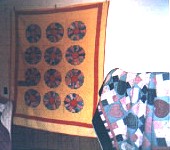 Nearing
the end of the 19th century, in Ontario, Adelaide Hunter Hoodless lost her 18
month old child to an illness caused by unpasteurized milk. She wanted to spare
others this tragedy and believed that educating
mothers would help with prevention. She formed the "Women's
Institute" in 1897. The purpose was to raise the standard of homemaking
and health through improvement of the intellectual and cultural life of women
living in rural areas of Canada. With the support of the provincial Departments
of Agriculture, branches formed throughout Canada. Locally, the organization
became known as WINS, Women's Institute of Nova Scotia. Programming was geared
toward building the skills homemakers already had for quilting, hooking rugs,
and weaving; and helping them to sell their products for income there and
abroad. WINS held exhibits, demonstrations and rallies. The members entered
quilting competitions locally and beyond, promoting the craft and economic
benefits of quiltmaking to other women. WINS continued its efforts with women
new to quilting when the revival came in the 1970s. Nearing
the end of the 19th century, in Ontario, Adelaide Hunter Hoodless lost her 18
month old child to an illness caused by unpasteurized milk. She wanted to spare
others this tragedy and believed that educating
mothers would help with prevention. She formed the "Women's
Institute" in 1897. The purpose was to raise the standard of homemaking
and health through improvement of the intellectual and cultural life of women
living in rural areas of Canada. With the support of the provincial Departments
of Agriculture, branches formed throughout Canada. Locally, the organization
became known as WINS, Women's Institute of Nova Scotia. Programming was geared
toward building the skills homemakers already had for quilting, hooking rugs,
and weaving; and helping them to sell their products for income there and
abroad. WINS held exhibits, demonstrations and rallies. The members entered
quilting competitions locally and beyond, promoting the craft and economic
benefits of quiltmaking to other women. WINS continued its efforts with women
new to quilting when the revival came in the 1970s.
Other religious and social groups besides WINS got involved in the Canadian
Red Cross and local
relief work in NS. They came together to make quilts especially during War.
The Canadian Red Cross sent quilts to Britain during WWII. The Nova Scotia
Division received this request: "The opportunity to help in...connection
with the 'World Refugee year'...I know you will be pleased to hear that what we
have been asked to make are layettes and quilts. As most of you do this work, I
feel sure we will have no difficulty to complete our extra quota of 250 layettes
and quilts. If each branch and auxiliary does a few more than usual we will go
'over the top'. Of course our regular quota must be reached, too, so our other
articles must be made as well."
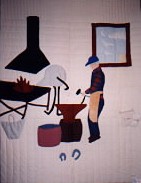
After the War, Nova Scotians developed their
own cultural identity, independent of the British Empire and American-style
nationalism. They chose their historical events and sentiments to reflect in the
quilts they made. These were often pictorial appliqué quilts. This trend
continues today as the quilters choose themes of national social issues such as
AIDS, peace, and the environment.
Click
here to continue . . .
Books from Amazon
See also my used books page for a copy:
Nova Scotia Patchwork Patterns
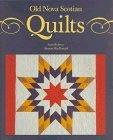
Old Nova Scotian
Quilts
by Scott Robson and Sharon MacDonald, 1995. It features
their active history of quilt-making and "50 of
the best quilts" from Nova Scotia Museum, of which Scott is the curator.
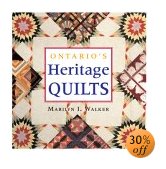
Ontario's Heritage Quilts
by Marilyn Walker, Noel Hudson (Editor)
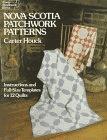
Nova
Scotia Patchwork Patterns: Instructions and Full-Size Templates for 12
Quilts
by Carter Houck
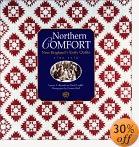
Northern
Comfort: New England's Early Quilts 1780-1850
by Jack Larkin, Lynne Z. Bassett, Thomas Neill (Photographer), Old
Sturbridge Village
|